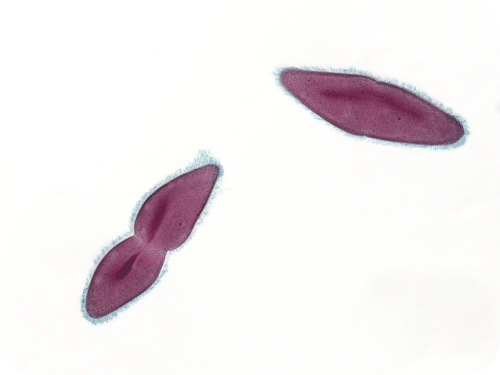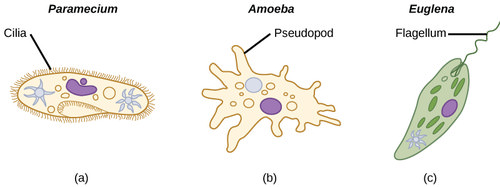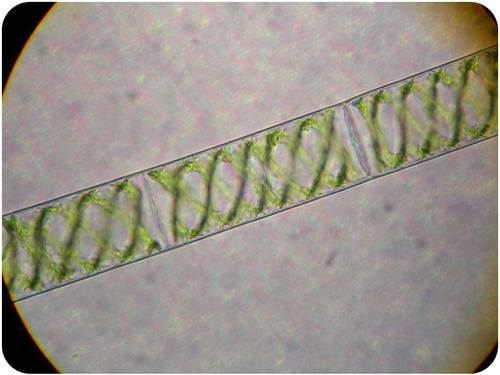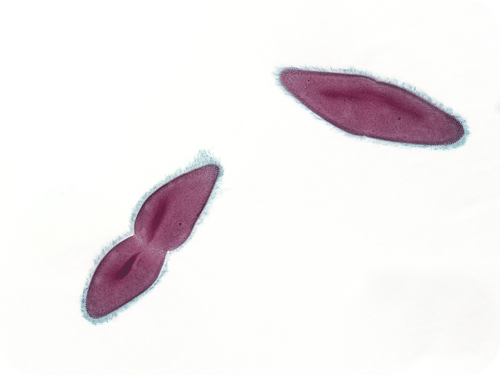8.10: Protist Characteristics
- Page ID
- 1472
\( \newcommand{\vecs}[1]{\overset { \scriptstyle \rightharpoonup} {\mathbf{#1}} } \)
\( \newcommand{\vecd}[1]{\overset{-\!-\!\rightharpoonup}{\vphantom{a}\smash {#1}}} \)
\( \newcommand{\dsum}{\displaystyle\sum\limits} \)
\( \newcommand{\dint}{\displaystyle\int\limits} \)
\( \newcommand{\dlim}{\displaystyle\lim\limits} \)
\( \newcommand{\id}{\mathrm{id}}\) \( \newcommand{\Span}{\mathrm{span}}\)
( \newcommand{\kernel}{\mathrm{null}\,}\) \( \newcommand{\range}{\mathrm{range}\,}\)
\( \newcommand{\RealPart}{\mathrm{Re}}\) \( \newcommand{\ImaginaryPart}{\mathrm{Im}}\)
\( \newcommand{\Argument}{\mathrm{Arg}}\) \( \newcommand{\norm}[1]{\| #1 \|}\)
\( \newcommand{\inner}[2]{\langle #1, #2 \rangle}\)
\( \newcommand{\Span}{\mathrm{span}}\)
\( \newcommand{\id}{\mathrm{id}}\)
\( \newcommand{\Span}{\mathrm{span}}\)
\( \newcommand{\kernel}{\mathrm{null}\,}\)
\( \newcommand{\range}{\mathrm{range}\,}\)
\( \newcommand{\RealPart}{\mathrm{Re}}\)
\( \newcommand{\ImaginaryPart}{\mathrm{Im}}\)
\( \newcommand{\Argument}{\mathrm{Arg}}\)
\( \newcommand{\norm}[1]{\| #1 \|}\)
\( \newcommand{\inner}[2]{\langle #1, #2 \rangle}\)
\( \newcommand{\Span}{\mathrm{span}}\) \( \newcommand{\AA}{\unicode[.8,0]{x212B}}\)
\( \newcommand{\vectorA}[1]{\vec{#1}} % arrow\)
\( \newcommand{\vectorAt}[1]{\vec{\text{#1}}} % arrow\)
\( \newcommand{\vectorB}[1]{\overset { \scriptstyle \rightharpoonup} {\mathbf{#1}} } \)
\( \newcommand{\vectorC}[1]{\textbf{#1}} \)
\( \newcommand{\vectorD}[1]{\overrightarrow{#1}} \)
\( \newcommand{\vectorDt}[1]{\overrightarrow{\text{#1}}} \)
\( \newcommand{\vectE}[1]{\overset{-\!-\!\rightharpoonup}{\vphantom{a}\smash{\mathbf {#1}}}} \)
\( \newcommand{\vecs}[1]{\overset { \scriptstyle \rightharpoonup} {\mathbf{#1}} } \)
\(\newcommand{\longvect}{\overrightarrow}\)
\( \newcommand{\vecd}[1]{\overset{-\!-\!\rightharpoonup}{\vphantom{a}\smash {#1}}} \)
\(\newcommand{\avec}{\mathbf a}\) \(\newcommand{\bvec}{\mathbf b}\) \(\newcommand{\cvec}{\mathbf c}\) \(\newcommand{\dvec}{\mathbf d}\) \(\newcommand{\dtil}{\widetilde{\mathbf d}}\) \(\newcommand{\evec}{\mathbf e}\) \(\newcommand{\fvec}{\mathbf f}\) \(\newcommand{\nvec}{\mathbf n}\) \(\newcommand{\pvec}{\mathbf p}\) \(\newcommand{\qvec}{\mathbf q}\) \(\newcommand{\svec}{\mathbf s}\) \(\newcommand{\tvec}{\mathbf t}\) \(\newcommand{\uvec}{\mathbf u}\) \(\newcommand{\vvec}{\mathbf v}\) \(\newcommand{\wvec}{\mathbf w}\) \(\newcommand{\xvec}{\mathbf x}\) \(\newcommand{\yvec}{\mathbf y}\) \(\newcommand{\zvec}{\mathbf z}\) \(\newcommand{\rvec}{\mathbf r}\) \(\newcommand{\mvec}{\mathbf m}\) \(\newcommand{\zerovec}{\mathbf 0}\) \(\newcommand{\onevec}{\mathbf 1}\) \(\newcommand{\real}{\mathbb R}\) \(\newcommand{\twovec}[2]{\left[\begin{array}{r}#1 \\ #2 \end{array}\right]}\) \(\newcommand{\ctwovec}[2]{\left[\begin{array}{c}#1 \\ #2 \end{array}\right]}\) \(\newcommand{\threevec}[3]{\left[\begin{array}{r}#1 \\ #2 \\ #3 \end{array}\right]}\) \(\newcommand{\cthreevec}[3]{\left[\begin{array}{c}#1 \\ #2 \\ #3 \end{array}\right]}\) \(\newcommand{\fourvec}[4]{\left[\begin{array}{r}#1 \\ #2 \\ #3 \\ #4 \end{array}\right]}\) \(\newcommand{\cfourvec}[4]{\left[\begin{array}{c}#1 \\ #2 \\ #3 \\ #4 \end{array}\right]}\) \(\newcommand{\fivevec}[5]{\left[\begin{array}{r}#1 \\ #2 \\ #3 \\ #4 \\ #5 \\ \end{array}\right]}\) \(\newcommand{\cfivevec}[5]{\left[\begin{array}{c}#1 \\ #2 \\ #3 \\ #4 \\ #5 \\ \end{array}\right]}\) \(\newcommand{\mattwo}[4]{\left[\begin{array}{rr}#1 \amp #2 \\ #3 \amp #4 \\ \end{array}\right]}\) \(\newcommand{\laspan}[1]{\text{Span}\{#1\}}\) \(\newcommand{\bcal}{\cal B}\) \(\newcommand{\ccal}{\cal C}\) \(\newcommand{\scal}{\cal S}\) \(\newcommand{\wcal}{\cal W}\) \(\newcommand{\ecal}{\cal E}\) \(\newcommand{\coords}[2]{\left\{#1\right\}_{#2}}\) \(\newcommand{\gray}[1]{\color{gray}{#1}}\) \(\newcommand{\lgray}[1]{\color{lightgray}{#1}}\) \(\newcommand{\rank}{\operatorname{rank}}\) \(\newcommand{\row}{\text{Row}}\) \(\newcommand{\col}{\text{Col}}\) \(\renewcommand{\row}{\text{Row}}\) \(\newcommand{\nul}{\text{Nul}}\) \(\newcommand{\var}{\text{Var}}\) \(\newcommand{\corr}{\text{corr}}\) \(\newcommand{\len}[1]{\left|#1\right|}\) \(\newcommand{\bbar}{\overline{\bvec}}\) \(\newcommand{\bhat}{\widehat{\bvec}}\) \(\newcommand{\bperp}{\bvec^\perp}\) \(\newcommand{\xhat}{\widehat{\xvec}}\) \(\newcommand{\vhat}{\widehat{\vvec}}\) \(\newcommand{\uhat}{\widehat{\uvec}}\) \(\newcommand{\what}{\widehat{\wvec}}\) \(\newcommand{\Sighat}{\widehat{\Sigma}}\) \(\newcommand{\lt}{<}\) \(\newcommand{\gt}{>}\) \(\newcommand{\amp}{&}\) \(\definecolor{fillinmathshade}{gray}{0.9}\)
Sexual or asexual reproduction for protists?
Notice how the Paramecium is dividing into two cells. This, obviously, is a form of asexual reproduction. But, remember that protists are an extremely diverse kingdom, and some protists can also reproduce sexually.
Characteristics of Protists
Like all other eukaryotes, protists have a nucleus containing their DNA. They also have other membrane-bound organelles, such as mitochondria and the endoplasmic reticulum. Most protists are single-celled. Some are multicellular. Because the protist kingdom is so diverse, their ways of getting food and reproducing vary widely.
Protist Habitats
Most protists are aquatic organisms. They need a moist environment to survive. They are found mainly in damp soil, marshes, puddles, lakes, and the ocean. Some protists are free-living organisms. Others are involved in symbiotic relationships. They live in or on other organisms, including humans.
Motility of Protists
Most protists have motility. This is the ability to move. Protists have three types of appendages for movement. As shown in Figure below, they may have flagella, cilia, or pseudopods (“false feet”). There may be one or more whip-like flagella. Cilia are similar to flagella, except they are shorter and there are more of them. They may completely cover the surface of the protist cell. Pseudopods are temporary, foot-like extensions of the cytoplasm.
 Protists use cilia, pseudopods, or flagella to move.
Protists use cilia, pseudopods, or flagella to move.Protist Reproduction
Protists have complex life cycles. Many have both asexual and sexual reproduction. An example is a protist called Spirogyra, a type of algae, shown Figure below. It usually exists as haploid cells that reproduce by binary fission. In a stressful environment, such as one that is very dry, Spirogyra may produce tough spores that can withstand harsh conditions. Spores are reproductive cells produced by protists and various other organisms. If two protist spores are close together, they can fuse to form a diploid zygote. This is a type of sexual reproduction. The zygote then undergoes meiosis, producing haploid cells that repeat the cycle.
 Spirogyra is a genus of algae with a complex life cycle. Each organism consists of rectangular cells connected end-to-end in long filaments.
Spirogyra is a genus of algae with a complex life cycle. Each organism consists of rectangular cells connected end-to-end in long filaments.Protist Nutrition
Protists get food in one of three ways. They may ingest, absorb, or make their own organic molecules.
- Ingestive protists ingest, or engulf, bacteria and other small particles. They extend their cell wall and cell membrane around the food item, forming a food vacuole. Then enzymes digest the food in the vacuole.
- Absorptive protists absorb food molecules across their cell membranes. This occurs by diffusion. These protists are important decomposers.
- Photosynthetic protists use light energy to make food. They are major producers in aquatic ecosystems.
Summary
- Protists have nuclear membranes around their DNA. They also have other membrane-bound organelles.
- Many protists live in aquatic habitats, and most are motile, or able to move.
- Protists have complex life cycles that may include both sexual and asexual reproduction.
- Protists get food through ingestion, absorption, or photosynthesis.
Review
- Identify three structures that protists use to move.
- Describe three ways that protists get food.
- Describe asexual and sexual reproduction in protists.
| Image | Reference | Attributions |
 |
[Figure 1] | Credit: Lebendkulturen.de License: CC BY-NC |
 |
[Figure 2] | Credit: Miranda Dudzik Source: http://cnx.org/content/m48073/latest/#fig-ch23_02_02 License: CC BY 3.0 |
 |
[Figure 3] | Credit: User:Spicywalnut/Wikipedia Source: commons.wikimedia.org/wiki/File:Spirogyra.JPG License: Public Domain |

